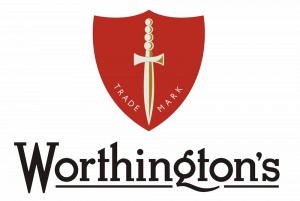
Pale ale is a golden to amber coloured beer style brewed with pale malt. The term first appeared in England around 1703 for beers made from malts dried with high-carbon coke, which resulted in a lighter colour than other beers popular at that time. Different brewing practices and hop quantities have resulted in a range of tastes and strengths within the pale ale family.

Burton upon Trent, also known as Burton-on-Trent or simply Burton, is a market town in the borough of East Staffordshire in the county of Staffordshire, England, close to the border with Derbyshire. In 2021, it had a population of 76,270. The demonym for residents of the town is Burtonian. Burton is located 11 miles (18 km) south-west of Derby, 30 miles (48 km) north-east of Birmingham, 27 miles (43 km) north-west of Leicester, 28 miles (45 km) west-south-west of Nottingham and 20 miles (32 km) south of the southern entrance to the Peak District National Park.

Bass Brewery was founded in 1777 by William Bass in Burton-upon-Trent, Staffordshire, England. The main brand was Bass Pale Ale, once the highest-selling beer in the UK. By 1877, Bass had become the largest brewery in the world, with an annual output of one million barrels. Its pale ale was exported throughout the British Empire, and the company's red triangle became the UK's first registered trade mark.

Beer has been brewed in England for thousands of years. As a beer brewing country, it is known for top fermented cask beer which finishes maturing in the cellar of the pub rather than at the brewery and is served with only natural carbonation.

Jennings Brewery was established as a family concern in 1828 in the village of Lorton, between Buttermere and Cockermouth in the Lake District, England. The brewery was started by John Jennings Snr, son of William Jennings. Jennings brewed exclusively in Lorton until 1874 when its present home, the Castle Brewery in Cockermouth, was purchased. The Lorton brewery closed some five years later.

Worthington Brewery, also known as Worthington & Co. and Worthington's, is a British brewer founded by William Worthington in Burton upon Trent in 1761. It is the third oldest continuously brewed British beer brand, after Shepherde Neame and Whitbread. The best known Worthington beers are its Creamflow nitrokeg bitter and White Shield India Pale Ale.

Thomas Salt and Co. was a brewery that operated in Burton upon Trent, England, between 1774 and 1927; over 150 years.

The remains of Letheringsett Brewery Watermill are located in the centre of the village of Letheringsett in the county of Norfolk. The watermill of 1784 was housed within the maltings and brewery complex founded and run by John Brereton of Letheringsett Hall from before 1721. Much of this complex still stands on the south side of the A148 Cromer to King's Lynn road, which bisects the village on an east–west axis, and on the west bank of the River Glaven, which bisects the village south–north.
James Eadie (1827–1904) was a Scottish brewer who founded an eponymous brewery in Burton on Trent which operated for 90 years.

St Dominic's Priory School is an independent Catholic day school in the town of Stone, Staffordshire, halfway between Stoke-on-Trent and Stafford. The school buildings are set near to the grounds of St Dominic's Convent.
Coors Brewers Limited, later known as Molson Coors Brewing Company (UK) Limited, is the UK arm of Molson Coors Beverage Company. Its headquarters is in Burton upon Trent, Staffordshire. The company originates from Bass Brewers Limited. The company has gone through many name changes and mergers.
Beer is produced through steeping a sugar source in water and then fermenting with yeast. Brewing has taken place since around the 6th millennium BC, and archeological evidence suggests that this technique was used in ancient Egypt. Descriptions of various beer recipes can be found in Sumerian writings, some of the oldest known writing of any sort. Brewing is done in a brewery by a brewer, and the brewing industry is part of most western economies. In 19th century Britain, technological discoveries and improvements such as Burtonisation and the Burton Union system significantly changed beer brewing.
Worthington's White Shield was an India pale ale (IPA) available principally in bottle conditioned form.

Samuel Adams is the flagship brand of the Boston Beer Company. It is named after US Founding Father Samuel Adams, who inherited his father's brewery on Boston's King Street and worked as a brewer or maltster. Samuel Adams beer is brewed by the Boston Beer Company, which was founded by Jim Koch in Cambridge, MA, where he started the micro-brewery in his home. Koch comes from a long line of Cincinnati brewers, and Samuel Adams beer was started using a recipe now known as Samuel Adams Boston Lager.

Pivovar Broumov is a small east Bohemian brewery located in Broumov, Olivětín, Czech Republic. The brewery produces light, dark, and amber beers, both filtered and unfiltered. Additionally, it produces several types of flavored beers with fruit, spiced, and herbal varieties.

Burton ale is a type of strong ale which is dark and sweet. It is named after the brewing town of Burton-on-Trent.

The Burton Cooper is a 1977 statue by James Walter Butler currently located in Coopers Square shopping centre, Burton upon Trent. The statue commemorates the close connection of the town to the trade, which was key to Burton's brewing industry. Originally situated outdoors, the statue was relocated inside the centre when it was refurbished in 1994.
A malt shovel is a shovel used during malting, part of the brewing process.

The Burton upon Trent war memorial commemorates those from the town that were killed in the First and Second World Wars. The memorial was commissioned by the county borough of Burton upon Trent from sculptor Henry Charles Fehr shortly after the end of the First World War. The finished memorial was unveiled by William Legge, 6th Earl of Dartmouth on 2 August 1922. Its principal figure is that of Victory, standing atop a pedestal that is flanked by the smaller figures of Saint George and Peace. The memorial is a grade II* listed building.















